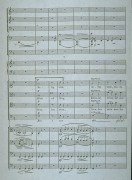 Johannes Brahms (1833 Hamburg - 1897 Wien) war in
Religionsfragen sehr skeptisch. Er wählte daher
für das Deutsche Requiem (1869) einen Text
ohne Christusbezug. Bezeichnend dafür ist, daß
am Schluß nicht der Erlösungstod Christi
verherrlicht wird, sondern Brahms auf der etwas
sonderbaren Schlußformulierung Selig sind die
Toten, die in dem Herrn sterben, von nun an beharrte.
Andererseits stellt er damit einen textlichen Bezug zum
Kyrie her, das die Bergpredigt vertont. Aber nicht nur
der Text, sondern auch der musikalische Schluß der
beiden Sätze ist parallel, der Kreis zwischen
Lebenden und Toten hat sich geschlossen. Johannes Brahms (1833 Hamburg - 1897 Wien) war in
Religionsfragen sehr skeptisch. Er wählte daher
für das Deutsche Requiem (1869) einen Text
ohne Christusbezug. Bezeichnend dafür ist, daß
am Schluß nicht der Erlösungstod Christi
verherrlicht wird, sondern Brahms auf der etwas
sonderbaren Schlußformulierung Selig sind die
Toten, die in dem Herrn sterben, von nun an beharrte.
Andererseits stellt er damit einen textlichen Bezug zum
Kyrie her, das die Bergpredigt vertont. Aber nicht nur
der Text, sondern auch der musikalische Schluß der
beiden Sätze ist parallel, der Kreis zwischen
Lebenden und Toten hat sich geschlossen.
Das
Hörbeispiel stellt das Kyrie vor, wobei besonders
auf die ersten drei Töne im Sopran zu verweisen ist,
die in variierter Form immer wiederkehren und so als
übergeordnetes thematisches Element die einzelnen
Sätze verbinden. (E. Stadler)
|




